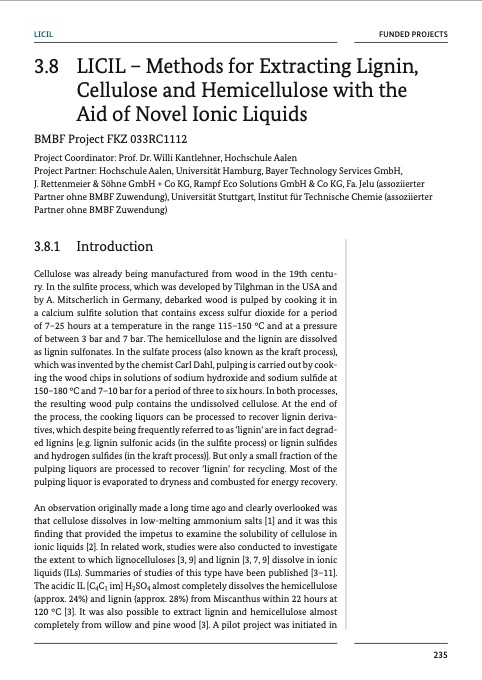
PDF Publication Title:
Text from PDF Page: 238
LICIL FUNDED PROJECTS 3.8 LICIL – Methods for Extracting Lignin, Cellulose and Hemicellulose with the Aid of Novel Ionic Liquids BMBF Project FKZ 033RC1112 Project Coordinator: Prof. Dr. Willi Kantlehner, Hochschule Aalen Project Partner: Hochschule Aalen, Universität Hamburg, Bayer Technology Services GmbH, J. Rettenmeier & Söhne GmbH + Co KG, Rampf Eco Solutions GmbH & Co KG, Fa. Jelu (assoziierter Partner ohne BMBF Zuwendung), Universität Stuttgart, Institut für Technische Chemie (assoziierter Partner ohne BMBF Zuwendung) 3.8.1 Introduction Cellulose was already being manufactured from wood in the 19th centu- ry. In the sulfite process, which was developed by Tilghman in the USA and by A. Mitscherlich in Germany, debarked wood is pulped by cooking it in a calcium sulfite solution that contains excess sulfur dioxide for a period of 7–25 hours at a temperature in the range 115–150 °C and at a pressure of between 3 bar and 7 bar. The hemicellulose and the lignin are dissolved as lignin sulfonates. In the sulfate process (also known as the kraft process), which was invented by the chemist Carl Dahl, pulping is carried out by cook- ing the wood chips in solutions of sodium hydroxide and sodium sulfide at 150–180 °C and 7–10 bar for a period of three to six hours. In both processes, the resulting wood pulp contains the undissolved cellulose. At the end of the process, the cooking liquors can be processed to recover lignin deriva- tives, which despite being frequently referred to as ‘lignin’ are in fact degrad- ed lignins [e.g. lignin sulfonic acids (in the sulfite process) or lignin sulfides and hydrogen sulfides (in the kraft process)]. But only a small fraction of the pulping liquors are processed to recover ‘lignin’ for recycling. Most of the pulping liquor is evaporated to dryness and combusted for energy recovery. An observation originally made a long time ago and clearly overlooked was that cellulose dissolves in low-melting ammonium salts [1] and it was this finding that provided the impetus to examine the solubility of cellulose in ionic liquids [2]. In related work, studies were also conducted to investigate the extent to which lignocelluloses [3, 9] and lignin [3, 7, 9] dissolve in ionic liquids (ILs). Summaries of studies of this type have been published [3–11]. The acidic IL [C4C1 im] H2SO4 almost completely dissolves the hemicellulose (approx. 24%) and lignin (approx. 28%) from Miscanthus within 22 hours at 120 °C [3]. It was also possible to extract lignin and hemicellulose almost completely from willow and pine wood [3]. A pilot project was initiated in 235PDF Image | Chemical Processes and Use of CO2

PDF Search Title:
Chemical Processes and Use of CO2Original File Name Searched:
CO2_Buch_engl.pdfDIY PDF Search: Google It | Yahoo | Bing
NFT (Non Fungible Token): Buy our tech, design, development or system NFT and become part of our tech NFT network... More Info
IT XR Project Redstone NFT Available for Sale: NFT for high tech turbine design with one part 3D printed counter-rotating energy turbine. Be part of the future with this NFT. Can be bought and sold but only one design NFT exists. Royalties go to the developer (Infinity) to keep enhancing design and applications... More Info
Infinity Turbine IT XR Project Redstone Design: NFT for sale... NFT for high tech turbine design with one part 3D printed counter-rotating energy turbine. Includes all rights to this turbine design, including license for Fluid Handling Block I and II for the turbine assembly and housing. The NFT includes the blueprints (cad/cam), revenue streams, and all future development of the IT XR Project Redstone... More Info
Infinity Turbine ROT Radial Outflow Turbine 24 Design and Worldwide Rights: NFT for sale... NFT for the ROT 24 energy turbine. Be part of the future with this NFT. This design can be bought and sold but only one design NFT exists. You may manufacture the unit, or get the revenues from its sale from Infinity Turbine. Royalties go to the developer (Infinity) to keep enhancing design and applications... More Info
Infinity Supercritical CO2 10 Liter Extractor Design and Worldwide Rights: The Infinity Supercritical 10L CO2 extractor is for botanical oil extraction, which is rich in terpenes and can produce shelf ready full spectrum oil. With over 5 years of development, this industry leader mature extractor machine has been sold since 2015 and is part of many profitable businesses. The process can also be used for electrowinning, e-waste recycling, and lithium battery recycling, gold mining electronic wastes, precious metals. CO2 can also be used in a reverse fuel cell with nafion to make a gas-to-liquids fuel, such as methanol, ethanol and butanol or ethylene. Supercritical CO2 has also been used for treating nafion to make it more effective catalyst. This NFT is for the purchase of worldwide rights which includes the design. More Info
NFT (Non Fungible Token): Buy our tech, design, development or system NFT and become part of our tech NFT network... More Info
Infinity Turbine Products: Special for this month, any plans are $10,000 for complete Cad/Cam blueprints. License is for one build. Try before you buy a production license. May pay by Bitcoin or other Crypto. Products Page... More Info
| CONTACT TEL: 608-238-6001 Email: greg@infinityturbine.com | RSS | AMP |